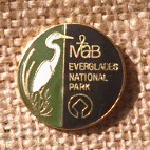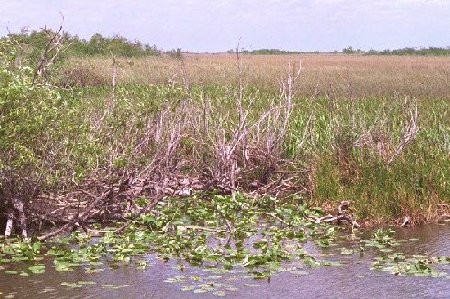![]()


"There
are no other Everglades in the world. . .
The miracle of the light pours over the green and brown expanse of saw
grass
and of water, shining and slow-moving below, the grass and water that is
the
meaning and the central fact of the Everglades of Florida. It is a river
of grass."
Marjory Stoneman Douglas, The Everglades:
River of Grass.
![]()

View of the Everglades from the Anhinga Trail.
© Antonio Fernandez, 1997.
The Everglades National Park is a unique place in the whole world. It was established as a National Park on December 6, 1947. Also, its uniqueness has deserved to be declared a World Heritage Site as well as an International Biosphere Reserve. This park with its 1,400,533 acres is the fourth largest within the contiguous 48 states of the Nation.
The park represents only a fraction of a natural area known as the Everglades that extends south of Lake Okeechobee down to Florida Bay. It is a hundred-mile-long subtropical wilderness of saw-grass prairies and swamps. The National Park is a small section that protects just the southern tip of this fragile region.
This page is created out of our love for this park, a park that is almost in our backyard. A place that we appreciate for its tranquility, its peacefulness. A place that serves as a refuge for many migratory birds as they fly over the Southern tip of Florida in their migratory flights twice every year for centuries, long before any humans inhabited this area, that Marjory Stoneman Douglas --its closer friend and most effective defender--, called the "River of Grass."
The objective of these pages is to invite you to visit the Everglades, to care and help to protect it. This site's intention is to provide information about the Park, to offer links to other pages related to this unique region and to help you to make your visit more pleasant and enjoyable.
The idea of the Everglades in almost everybody's
mind is always associated to the presence of it most known and famous habitant:
the alligator. The alligator has been called by many "the keeper of
the Everglades." The alligator builds a very unique ecosystem in what
is known as the "alligator hole."  With
feet and snout these animals clear out the vegetation creating a large
hole in the limestone. In the dry season these holes are like oases where
a large number of fish, turtles, snails, and other fresh-water creatures
take refuge and survive the dry months waiting for the rain to come down
again and then reproduce and begin a new cycle of life.
With
feet and snout these animals clear out the vegetation creating a large
hole in the limestone. In the dry season these holes are like oases where
a large number of fish, turtles, snails, and other fresh-water creatures
take refuge and survive the dry months waiting for the rain to come down
again and then reproduce and begin a new cycle of life.
We assure you that during any visit --regardless of how extensive it is-- you will be able to discover this magnificent reptile basking in the sun or just floating along fresh-water inland streams. For many visitors --especially for the youngest-- this encounter is an unforgettable experience.
Photo © Antonio Fernandez, 1997 - An alligator seen in the Shark Valley section of the park.
![]()
![]()
To return
to the Main
Page |
Please,
share with us your opinions and suggestions: |